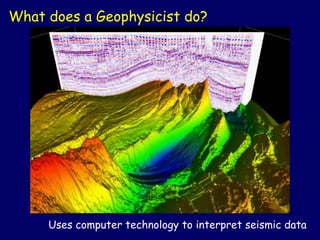All Categories
Featured
Table of Contents
Bs In Physics: Geophysics in Marangaroo Oz 2021

The primary model for the radial structure of the interior of the Earth is the initial referral Earth design (PREM). Some parts of this model have actually been updated by recent findings in mineral physics (see post-perovskite) and supplemented by seismic tomography. The mantle is mainly composed of silicates, and the limits between layers of the mantle follow phase shifts.

This makes plate tectonics possible. Schematic of Earth's magnetosphere. The solar wind circulations from delegated right. If a planet's magnetic field is strong enough, its interaction with the solar wind forms a magnetosphere. Early space probes mapped out the gross measurements of the Earth's magnetic field, which extends about 10 Earth radii towards the Sun.
Inside the magnetosphere, there are fairly dense regions of solar wind particles called the Van Allen radiation belts. Geophysical measurements are generally at a particular time and location. Accurate measurements of position, in addition to earth deformation and gravity, are the province of geodesy. While geodesy and geophysics are different fields, the 2 are so closely connected that lots of clinical organizations such as the American Geophysical Union, the Canadian Geophysical Union and the International Union of Geodesy and Geophysics include both.
What Is Geophysics? in Swan View Western Australia 2021
, combines astronomical collaborates and the regional gravity vector to get geodetic coordinates. This approach only offers the position in 2 collaborates and is more hard to use than GPS.
Gravity measurements became part of geodesy because they were needed to associated measurements at the surface area of the Earth to the recommendation coordinate system.
Satellites in area have actually made it possible to collect information from not only the visible light region, but in other areas of the electro-magnetic spectrum. The planets can be defined by their force fields: gravity and their electromagnetic fields, which are studied through geophysics and area physics. Determining the changes in acceleration experienced by spacecraft as they orbit has permitted fine details of the gravity fields of the worlds to be mapped.
Geophysicist Job Description: Salary, Duties, & More in Noranda Australia 2020

Since geophysics is worried about the shape of the Earth, and by extension the mapping of functions around and in the world, geophysical measurements include high accuracy GPS measurements. These measurements are processed to increase their accuracy through differential GPS processing. As soon as the geophysical measurements have been processed and inverted, the analyzed results are outlined using GIS.
Many geophysics business have designed internal geophysics programs that pre-date Arc, GIS and Geo, Soft in order to meet the visualization requirements of a geophysical dataset. Expedition geophysics is applied geophysics that often uses remote picking up platforms such as; satellites, airplane, ships, boats, rovers, drones, borehole noticing equipment, and seismic receivers.
For instance, aeromagnetic data (airplane gathered magnetic data) gathered utilizing conventional fixed-wing aircraft platforms should be remedied for electromagnetic eddy currents that are developed as the airplane moves through Earth's magnetic field. There are likewise corrections related to modifications in measured potential field strength as the Earth turns, as the Earth orbits the Sun, and as the moon orbits the Earth.
Your Degree In Geophysics in Middle Swan Aus 2022
Signal processing involves the correction of time-series data for unwanted sound or errors introduced by the measurement platform, such as aircraft vibrations in gravity data. It also involves the reduction of sources of sound, such as diurnal corrections in magnetic information. In seismic information, electromagnetic data, and gravity information, processing continues after mistake corrections to consist of computational geophysics which lead to the last interpretation of the geophysical data into a geological interpretation of the geophysical measurements Geophysics became a different discipline only in the 19th century, from the intersection of physical geography, geology, astronomy, meteorology, and physics.
The magnetic compass existed in China back as far as the fourth century BC. It was not up until excellent steel needles could be forged that compasses were utilized for navigation at sea; prior to that, they might not maintain their magnetism long enough to be helpful.
By looking at which of eight toads had the ball, one could identify the instructions of the earthquake.'s (1600 ), a report of a series of meticulous experiments in magnetism.
Career Guide: Geophysicist in Hamilton Hill Western Australia 2023
In 1687 Isaac Newton published his, which not only laid the foundations for classical mechanics and gravitation but also discussed a range of geophysical phenomena such as the tides and the precession of the equinox. The first seismometer, an instrument efficient in keeping a constant record of seismic activity, was developed by James Forbes in 1844. Dietmar; Sdrolias, Maria; Gaina, Carmen; Roest, Walter R. (April 2008). "Age, spreading rates, and spreading out asymmetry of the world's ocean crust". Geochemistry, Geophysics, Geosystems. 9 (4 ): Q04006. Bibcode:2008 GGG ... 9. 4006M. doi:10. 1029/2007GC001743. S2CID 15960331. "Earth's Inconstant Magnetic Field". science@nasa. National Aeronautics and Space Administration. 29 December 2003. Recovered 13 November 2018.
Leipzig. Berlin (Gebruder Borntraeger). Runcorn, S.K, (editor-in-chief), 1967, International dictionary of geophysics:. Pergamon, Oxford, 2 volumes, 1,728 pp., 730 fig Geophysics, 1970, Encyclopaedia Britannica, Vol. 10, p. 202-202 Ross 1995, pp. 236242 Shearer, Peter M. (2009 ). Introduction to seismology (2nd ed.). Cambridge: Cambridge University Press. ISBN 9780521708425. Stphane, Sainson (2017 ).
Latest Posts
What Geophysicists Do in Iluka WA 2023
Geophysical Survey Definition in Casaurina Oz 2021
Geology And Geophysics - Careers And Employment in Manning Aus 2022